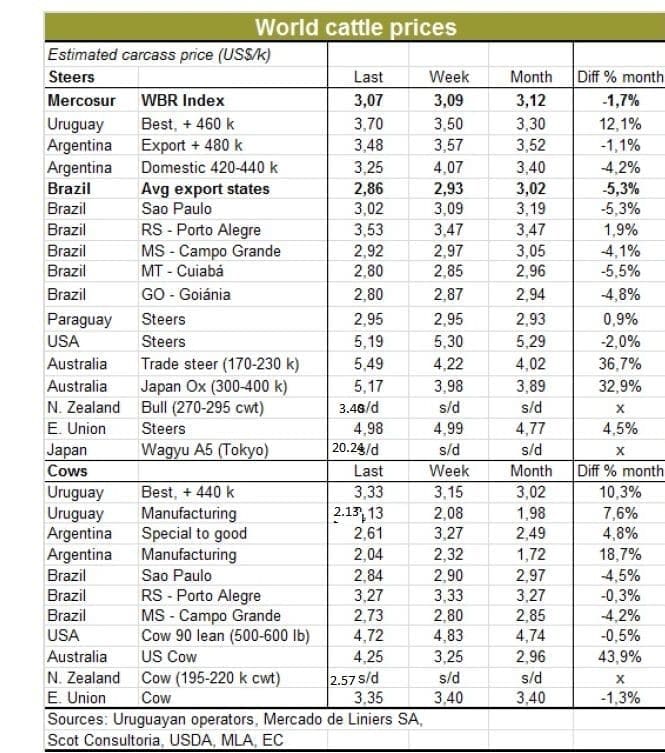AUSTRALIA has gone from close to the bottom of the ‘league table’ rankings in world cattle prices, to the top, based on a regular pricing summary conducted in South America’s World Beef Report last week.
The result clearly captures the historic movement in cattle values experienced in Australia since early May, driven by buoyant global demand, the lower Aussie dollar, and declining supply of slaughter stock in many regions. It also reflects generally declining prices in North and South America.
With the exception of Japan, where the price recorded by World Beef Report is in fact for Wagyu A5 beef instead of conventional breeds – making the comparison irrelevant – Australian steers last week were the most expensive of the 16 countries and regions monitored for the report. The figures for each country are converted into US$, and presented on a carcase weight US$/kg basis.
Using MLA-supplied data, WBR’s July 22 report had Australian trade steer 170-230kg at US549c/kg, and heavier Jap ox +300kg at 517c/kg.
Next highest was US domestic steer, quoted at 519c/kg, and European Union steers, quoted at US498c/kg. Among the South American quotes offered, Uruguay steer (+460kg liveweight) was best at US370c/kg carcase weight, while Brazil’s average among export states was US307c/kg.
The table noted a 36.7pc increase in light trade steer price in Australia over this time a month ago (up from US422c in June), and a 32.9pc rise for Jap ox (US389c/kg in late June).
Cow price trends similar
In the cow price section of the report, Australian pricing also ranked highly, among the 11 regions and countries presented.
Australia’s US cow price quoted from MLA resources was US425c/kg, up from 296c/kg a month ago, a 43.9pc rise. Highest cow price for all regions was US domestic, at US472c/kg, reflecting the high domestic grinding beef demand and shortage of cows available for slaughter. Cow prices in Brazil ranged from US284c/kg to 327c/kg. European Union cows were worth the equivalent of US335c/kg last week.
European cattle prices have trended down due to the loss of region’s major export market in Russia and complaints in France of reduced meat processor and retailer competition.
US dressed beef prices have come down from the high levels of earlier in the year.
Source for statistics: World Beef Report issue 22 July 2015


Thanks Josie. I was scratching my head here and felt surely I was missing something. No Jaguar out the front of Cardowan yet. And yes, potentially very disruptive interpretation by World Beef Report. When there is a Jaguar there, I’ll let you know.
Of recent weeks it has been reported that in the U.S. feeders were making $6 a kg live a few weeks ago and more recently $8 a kg. if these figures are correct something doesn’t quite compute with the USA figures quoted in this World Beef Report table?
These are wild figures. Apparently we are receiving US$5.17/kg dressed for jap ox. That would be in excess of A$7/kg. Sounds good to me however simply not true. If you further correct for the huge disparity between US standard trim and our bare bones standard trim as Josie has already pointed out, the price would be pushing towards A$8/kg. The World Beef Report data is simply incorrect.
Given that the US dressed weight conversion is based on a 63pc live to dead conversion, I would suggest Australia still has some ground to make up. A story like this has the potential to harm us in a global market place, so it is important that it is put into some context. Maybe a good reason for a review of standard carcase trim in Australia?
You’ve touched on an interesting point, Josie – especially in the context of the current AusMeat/industry language and standards review. Let’s follow up with an article looking at dressing percentage, the AusMeat standards carcase trim and how it is calculated, and whether there are grounds for change. Here’s a USDA document with referecnes to expected US-defined dressing percentages from yield grade 3 cattle:
https://www.beefcentral.com/wp-content/uploads/2015/07/Beef-Cuts-Guide.compressed.pdf
Editor.